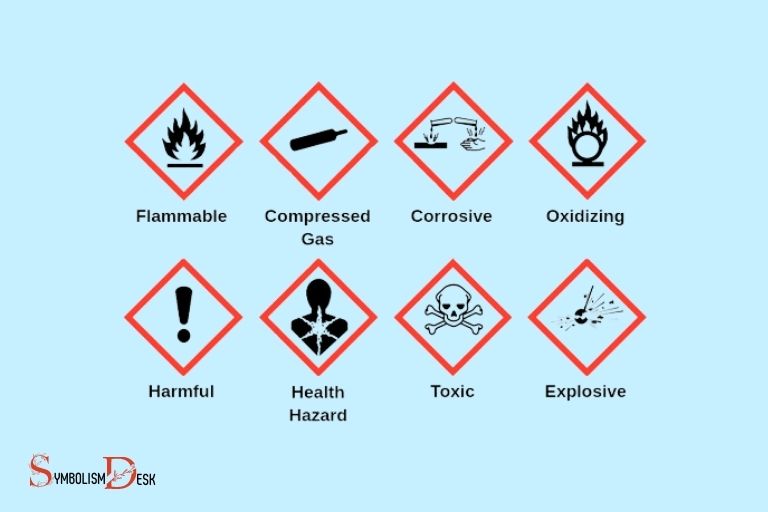Hazard Symbols And What They Mean? Visual Cues!
Hazard symbols are visual cues used globally to communicate possible dangers associated with specific substances.
They are used in various contexts such as workplace safety, product labeling, and transportation.
The symbols range from indicating flammable or toxic substances to biohazards and radioactive materials. Understanding their meanings is vital for safety and prevention of accidents.
Hazard symbols are part of the globally recognized system for classifying, labeling, and packaging chemicals.
These symbols are standardised, simple images that help to immediately communicate the specific hazards linked to the substance they are associated with.
They serve as a warning about the potential dangers, whether it be flammability, toxicity, corrosiveness, or others, and provide guidance on handling the substances safely.
Understanding hazard symbols is essential not only for professionals dealing with such substances but also for everyday consumers.
They serve as a communication tool to notify individuals of potential risks and provide guidance on how to handle these substances safely.
Not comprehending these symbols could lead to accidents and health hazards. Therefore, one must familiarize themselves with such symbols for their safety.
16 Hazard Symbols and Their Meanings
| Symbol | Meaning |
|---|---|
| Flame Symbol | The flame symbol indicates the presence of flammable materials, substances, or gases. It warns of the potential for fire or combustion. |
| Skull and Crossbones Symbol | The skull and crossbones symbol signifies toxic or poisonous substances. It alerts to the danger of exposure to materials that can cause harm or even be fatal. |
| Corrosion Symbol | The corrosion symbol depicts materials that can cause corrosion, leading to damage, decay, or deterioration of surfaces, materials, or skin upon contact. |
| Exploding Bomb Symbol | The exploding bomb symbol warns of explosive materials, substances, or mixtures that can detonate or create a hazardous explosion. |
| Gas Cylinder Symbol | The gas cylinder symbol represents compressed gases or liquefied gases stored under pressure. It alerts to the potential for gas leaks or pressurized releases. |
| Flame Over Circle Symbol | The flame over circle symbol indicates oxidizing materials that can accelerate the combustion of other substances and cause fires. |
| Environment Symbol | The environment symbol points to materials or actions that can harm the environment, such as pollution, toxic waste, or substances that damage ecosystems. |
| Health Hazard Symbol | The health hazard symbol warns of substances that can cause health effects, such as respiratory irritation, skin sensitization, carcinogenicity, or reproductive toxicity. |
| Biohazard Symbol | The biohazard symbol represents biological hazards, including infectious agents, pathogens, and materials that pose a risk to human health. |
| Radioactive Symbol | The radioactive symbol indicates the presence of radioactive materials that emit ionizing radiation. It warns of potential radiation exposure hazards. |
| Exclamation Mark Symbol | The exclamation mark symbol signifies materials or actions that may pose less severe hazards than those represented by other symbols but still require caution. |
| Gas Mask Symbol | The gas mask symbol warns of materials or environments that require protective measures, such as wearing respiratory protection, to avoid inhalation hazards. |
| Skull and Crossbones with Exclamation Mark Symbol | This symbol combines the toxic skull and crossbones with the exclamation mark, indicating a substance that is toxic and poses additional health hazards. |
| Chemical Storage Symbol | The chemical storage symbol is often used to mark containers or storage areas for hazardous chemicals and materials. It serves as a general warning of potential hazards. |
| Electric Shock Symbol | The electric shock symbol warns of electrical hazards, indicating areas or equipment where contact with electricity can result in shocks or other dangers. |
| Biohazard Warning Symbol (Alternate) | An alternate biohazard warning symbol is used to indicate biological hazards and infectious materials. It is recognized as a symbol of potential health risks. |
Key Takeaway

Five Facts About: Hazard Symbols and What They Mean
The Evolution Of Hazard Symbols
Throughout history, different industries have used various symbols to warn people about potential hazards.
In this section, we will dive into the history and development of hazard symbols, as well as the changes they have undergone over time.
The History And Development Of Hazard Symbols
Ancient civilizations used symbols to represent dangerous substances, such as the skull and crossbones for poisonous plants.
The first modern hazard symbol was introduced by the german chemist friedrich accum in the early 19th century. He used a skull and crossbones to indicate poisonous substances.
In 1911, the international association of stamped goods manufacturers created the first standardized hazard symbols to warn workers in the printing industry about the potential dangers of ink and solvents.
The united nations created the globally harmonized system (ghs) in 2002 to standardize hazard symbols globally.
The ghs has a set of criteria for hazard classification and communication including the use of signal words, hazard statements, and precautionary statements.
Changes In Hazard Symbols And Their Meanings Over Time
- The skull and crossbones symbol was initially used to represent poisonous substances but is now only used for acute toxicity.
- In 1966, the dot introduced a set of hazard symbols for use on transportation containers. These symbols use different shapes and colors to indicate specific hazards, such as flammable liquids or corrosive materials.
- In 2009, the ghs introduced new hazard symbols that replaced many of the previous symbols. The new symbols are easier to recognize, and they are used globally to represent specific hazardous materials.
- The ghs also standardized the meanings of hazard symbols, such as the skull and crossbones now only indicating acute toxicity and the exclamation mark symbol representing less severe hazards.
Hazard symbols have undergone significant changes throughout history, from ancient civilizations to modern times.
The evolution of these symbols has led to a standardized system that is easier to recognize and understand worldwide.
It is essential to know the history and changes in hazard symbols to ensure safety in the workplace and everyday life.
Types Of Hazard Symbols
Physical Hazard Symbols
Physical hazard symbols are used to alert people about substances, materials, or situations that can pose a physical threat or danger.
Here are the most common types of physical hazard symbols and their meanings:
- Explosive: Products that can explode under certain conditions, such as shock, heat, or friction. Example: fireworks and explosives for industrial use.
- Flammable: Items that can easily ignite and burn. Example: gasoline, alcohol, and wood products.
- Oxidizing: Materials that can cause other materials to burn when mixed. Example: bleach.
- Corrosive: Liquids or solids that can destroy materials or body tissues. Example: battery acid and drain cleaner.
- Gas under pressure: Any types of gas stored in high pressure or compressed form. Example: propane tanks and aerosol cans.
- Cryogenic: Substances that can cause extreme freezing or burning, such as liquid nitrogen.
Health Hazard Symbols
Health hazard symbols are used to alert people about substances or materials that can harm their health or cause illnesses.
Here are the most common types of health hazard symbols and their meanings:
- Toxic: Substances or materials that can cause serious health effects, including death. Example: pesticides and chemicals.
- Biohazard: Items containing bacteria, viruses, or other microorganisms that can cause infections or diseases. Example: medical waste.
- Radiological: Materials or substances that emit radiation and can cause damage to cells or body tissues. Example: nuclear waste.
- Carcinogen: Substances that can cause cancer. Example: tobacco smoke and asbestos.
- Harmful: Items that can cause less serious health effects, such as allergic reactions or skin irritation. Example: cleaning products.
Environmental Hazard Symbols
Environmental hazard symbols are used to alert people about substances that can harm or damage the environment.
Here are the most common types of environmental hazard symbols and their meanings:
- Explosive: Products that can harm or destroy the environment when exploded. Example: land mines.
- Flammable: Items that can ignite or burn and cause environmental damage, such as forest fires or oil spills.
- Toxic: Substances or materials that can harm wildlife or pollute soil, waterways or the air. Example: industrial waste and oil.
- Oxidizing: Materials that can cause environmental damage by causing fires and explosions. Example: chemicals used in agriculture.
- Corrosive: Materials that can cause environmental damage by breaking down materials over time. Example: acidic chemicals.
Interpretation Of Hazard Symbols
How To Read And Interpret Hazard Symbols
Have you ever come across a hazardous material and wondered what the symbols on its container mean? Hazard symbols are used to convey important information about the dangers associated with a substance.
Understanding these symbols, their meanings and the risks posed by each can help you stay safe in your daily life.
Here we’ll discuss how to read and interpret hazard symbols.
Understanding The Different Elements Of A Hazard Symbol
Hazard symbols are normally the same color, red, and include a black pictogram on a white background. The pictogram used is determined by the type of risk associated with the substance.
There are a variety of different pictograms used, but some common examples include:
- Flame: This icon is used for substances that can ignite and cause a fire.
- Skull and crossbones: This symbol indicates that the material is lethal and can cause death upon ingestion or contact.
- Health hazard: This symbol is used for substances which can cause acute or chronic health effects upon exposure.
- Corrosion: This icon is used for substances which can cause skin damage, corrosion of metals, or other tissue damage.
How To Understand The Severity Of The Risk
Apart from the pictogram, hazard symbols also have a geometric shape that helps to convey the level of risk associated with the substance.
The level of risk is communicated through the shape and color of the background.
For example:
- A circle with a black border indicates a carcinogen or substance that can cause cancer.
- A black diamond indicates a substance that is explosive or reactive.
- A yellow triangle with an exclamation mark indicates a substance that is harmful but not lethal.
How To Read Additional Information On The Label
In addition to the hazard symbols, labels on hazardous materials can provide additional information that should be taken into consideration when handling or using the substance.
This information may include first aid measures, storage recommendations, and precautions to take when handling the material.
Understanding hazard symbols and their meanings is an essential part of staying safe when handling hazardous substances.
When working with dangerous materials, always read the label carefully and take necessary steps to protect yourself and others around you.
Safety Measures Based On Hazard Symbols
The Importance Of Following Hazard Symbols
Hazard symbols are designed to provide a visual representation of potential dangers.
These symbols are used to communicate the risks associated with chemicals, equipment, and other potential hazards that may be present in your workplace.
It’s crucial to understand and follow hazard symbols to ensure that you and your coworkers remain safe while on the job.
Proper Safety Measures To Take Based On The Type Of Hazard Symbol
Following hazard symbols is the first step to staying safe, but it’s also important to understand which safety measures to take based on the type of symbol you encounter.
Here are some examples of different hazard symbols and the proper safety measures to take:
- Flammable materials: Keep away from heat sources, avoid spilling, and store properly.
- Toxic materials: Wear protective gear, avoid inhaling fumes, and handle with care.
- Explosive materials: Avoid shock, friction, and heat sources.
- Corrosive materials: Handle with gloves and goggles, avoid contact with skin and eyes, and neutralize spills with water or neutralizing agents.
- Biohazard materials: Handle with gloves and protective clothing, dispose of properly in designated biohazard waste containers.
Steps To Take In Case Of An Emergency
Accidents can happen, even when following safety protocols. It’s important to know what to do in case of an emergency.
Here are some steps to take:
- Call for help: Notify your supervisor, coworkers, or emergency services immediately.
- Evacuate: Follow evacuation procedures and leave the area quickly and calmly.
- Administer first aid: If possible, provide first aid to those who are injured while waiting for medical assistance.
- Report the incident: It’s important to report the incident to your supervisor so that they can take appropriate measures to prevent future incidents.
Following hazard symbols and taking the proper safety measures is crucial in maintaining a safe workplace.
Be sure to understand and follow all hazard symbols, know the appropriate safety measures based on the symbol you encounter, and know what to do in case of an emergency.
Stay vigilant and stay safe!
What Does the Hazards Safety Symbol Mean?
The safety symbol hazards is a universally recognized icon that indicates potential dangers in various settings. This symbol effectively communicates important safety precautions to individuals, ensuring their well-being and preventing accidents. Familiarizing yourself with the meaning of this symbol is crucial for maintaining a safe environment and minimizing risks.
FAQ About Hazard Symbols And What They Mean?
What Are Hazard Symbols?
Hazard symbols are a type of pictogram used to warn people of potential dangers associated with certain chemicals or substances.
What Is The Purpose Of Hazard Symbols?
Hazard symbols are designed to inform people about the potential risks associated with specific substances and provide guidance on how to handle them safely.
How Many Types Of Hazard Symbols Are There?
There are nine different types of hazard symbols, each representing a specific type of danger or risk associated with a substance or chemical.
What Do The Colors Of Hazard Symbols Mean?
The colors used in hazard symbols have specific meanings. For example, red generally indicates a fire hazard and yellow is used for substances that can cause serious health risks.
Why Is It Important To Know Hazard Symbols?
Knowing hazard symbols can help you identify potential dangers posed by different substances and chemicals and enable you to take the necessary precautions to protect yourself and others.
Conclusion
Overall, understanding hazard symbols is crucial to ensure our safety and the safety of those around us.
These symbols may seem small and insignificant, but they play a vital role in identifying and warning us of the potential dangers present in our surroundings. They serve as universal indicators that transcend language barriers, ensuring safety and awareness for everyone, regardless of their background. The symbolic significance explained in detail allows us to interpret these icons swiftly and act accordingly in critical situations. Whether it’s a skull and crossbones warning of poison or a flammable sign near hazardous materials, these symbols are designed to convey crucial information instantly.
By knowing what these symbols mean, we can take the necessary precautions to protect ourselves and prevent accidents from happening.
Whether it’s at home, in the workplace, or out in public, being able to recognize these hazard symbols is a valuable skill to have.
With the continuing development of technology and innovation, new hazards may arise in the future, but with the knowledge we have now, we can stay ahead of the game and stay safe.
So, let’s take a moment to appreciate the importance of hazard symbols and continue to educate ourselves on the potential hazards that surround us.






